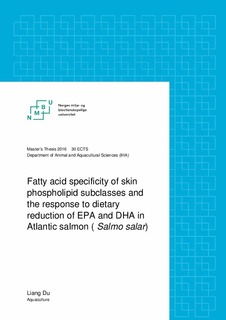| dc.description.abstract | Abstract
The different phospholipid classes play a critical role in cell membrane structure and function. Skin is the first barrier for the animal body to prevent environmental damage and are in addition to the gills also involved in osmoregulation. However, there are no earlier studies that have investigated the relationship between different dietary levels of either EPA, DHA or a mix of EPA and DHA on thefatty acid composition of Atlantic salmon skin PL subclasses. Therefore, we aimed to find the effects of n-3 PUFA deficiency for the fatty acid composition in Atlantic salmon skin PL subclasses.
The experimental fish was reared from 40 gram and divided into 14 groups. For each group, they were fed with one of 14 different diets. The diets were 12 different diets (0.5%, 1%, 1.5% and 2% of either EPA, DHA or a 1:1 mix of EPA+DHA, respectively) with one negative control diet (0% EPA + DHA) and one diet with a composition close to a commercial diet with 2,2% EPA+DHA. The skin samples was taken when the fish was 200 gram and 400 gram, for each group, the skin sample was analyzed in duplicates (in EPA or DHA group) or triplicates (in EPA+DHA, NC and CC group). TLC was applied in duplicate, to separate the different PL classes. GC was used to determine the fatty acid composition in the PL subclasses. PCA was used to do the statistical analysis.
Each PL subclass contains a unique fatty acid pattern regardless the diet group. But all of PL subclasses were affected by the different fatty acid compositions of the diets. The influence was more pronounced the longer time the fish had been fed the different diets, PS and PI are more conserved than PC and PE. 20:4n-6 is dynamically increased when EPA and DHA decreases in the PE and PI fractions, whereas an increase in 20:3n-6 follows the EPA and DHA decrease in the PS fraction. Moreover, PI fraction contains the highest percentage of 20:4n-6. An increase in short chain MUFAs in the PC and PS fractions was also observed when the EPA and DHA decreased, while the increase of some SFA (12:0, 16:0, 18:0) with EPA and DHA decrease was observed in almost all PL subclasses, except PC fraction. The percentage of DHA was significantly reduced in all Atlantic salmon skin PL classes, while a significant reduction of EPA was detected in the PC and PE fractions. Furthermore, DHA is much better retained in PE and PS group than in PC and PI fractions.
In general, 18:1n-9, some short chain SFA and n-6 PUFA increased with the dietary decrease in EPA and DHA, whereas n-3 lcPUFA decreased with dietary EPA and DHA decrease. | nb_NO |
